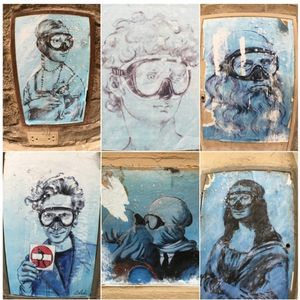Living History
M.A. in Political Science, European Union Policy Studies
By Claire Krisko
Art is a powerful way to communicate and preserve history, allowing contemporary viewers to experience moments of the ancient past. Images transcend language and time, and have the power to educate, interpret, and decorate the world. Italian culture brings out the zest of life through food, fashion, and ancient art, facilitating the flourishing of contemporary artistic creativity.
People from all over the world travel to the Tuscan capital to admire the genius and beauty of monuments that stand tall against the arc of time. Revolutionary scientists, artists and authors like Lenoardo Da Vinci, Michelangelo, and Boccaccio walked the same cobblestone alleyways we pass through every day. Their creative and intellectual achievements broke away from the restrictions of the Middle Ages towards an appreciation of the natural world, promoting the importance of anatomy, the human mind, and scientific thinking. The Uffizi Gallery, the Boboli Gardens, the Gallery of the Accademia, along with many other institutions and UNESCO heritage sites, offer opportunities to step into this golden era of the past. Most of the preserved Florentine masterpieces embody this major turning point in the human experience we call the Renaissance.
While the iconic pieces sit as the centerpiece of the city and on the walls of its museums, drawing in the crowds, the creation of art in Florence is not solely a relic of the past. Architecture in the heart of the city has remained the same, but the passage of time can be seen in the stratification of street art on the same ancient walls that witnessed the Renaissance. Colorful murals, stickers, stencils, and discrete images have become integral aspects of the city’s alternative artistic offerings. Contemporary local artisans utilize the creative energy embedded in the city for their own discovery. Environmentally charged fresh perspectives paint the city with new renditions of the human experience and encourage tourists to engage with the active art scene that circulates throughout the city.
Here are some noteworthy contemporary street artists to keep an eye out for:

“L’Arte Sa Nuotare” (art can swim) are works by an anonymous, by now very popular artist, who depicts Italian icons underwater, wearing a diving mask. Suspended underwater these figures are where “time stops, the weight of your body and thoughts disappear and go into another dimension” thus they are able to eternally influence us.

Clet Abraham is another famous visual artist who has been sneakily leaving his mark on road signs with removable stickers that creatively interact with the composition on the sign, while preserving its inherent meaning. These simple reworked street signs are not about defacing city property, but instead offering new ways to interpret and reflect on “society blindly taking orders”, through amusing public artwork.

Another Florentine artist, Exit/Enter, depicts minimalist stylised figures in simple scenes accompanied by a small red heart or balloon on deteriorated walls. The ambiguous works evoke different emotions from each person. When asked about the concept, the mysterious artist states how “life is a continuous change and an endless succession of situations, depending on your point of view, it can be experienced as an exit or an entrance to new possibilities”.
While these artists started their experiments in Florence, they have expanded to the cities of Naples, Rome, Palermo, Venice, and abroad to Brussels, Lisbon, Valencia, Barcelona, Amsterdam to challenge different audiences in new ways.
Another way local artisans present their work is on the weekends in open air markets that pop up throughout the city. Piazzas are transformed into buzzing hotspots with stands that burst with original ceramic, handmade jewelry, and vintage clothes that are unique, sustainable momentos. Opportunities to experience the contemporary vibe of the city bring perspectives together and further integrate one into the unique character of the city.
Florence offers a distinctive harmony of beauty that creates a special atmosphere and environment. Street art is popular throughout Italy and its peculiar qualities offer more direct, informal, and frequent opportunities to interact with the public. Claiming its own creative and expressive freedom, this kind of art reaches territories that remain elusive for traditional artists. The context in which street art is immersed adds to the pulsating energy it possesses. Its juxtaposition with the classic pieces housed in Florence’s world-famous galleries enhances its impact. Art in this city utilizes multiple mediums as powerful communication tools to provide its messages and creativity for all to experience. To live in Florence means to be immersed in both ancient and contemporary art, experiencing the best of both worlds, given by their coexistence.
Claire Krisko is a member of the 2022-2023 EUPS cohort and currently serves as a Graduate Assistant for the program. She received her B.S. in Studio Art and B.A. in Political Science from James Madison University in 2021, and participated in the JMU semester in Washington program in Fall of 2021. Prior to the program, she worked as a Marketing and Development intern with the Marshall Legacy Institute.
